
E-mail: font@focusonnature.com
Phone: Toll-free in USA 1-800-721-9986
or 302/529-1876; Fax: 302/529-1085
 |
PO
Box 9021, Wilmington, DE 19809, USA E-mail: font@focusonnature.com Phone: Toll-free in USA 1-800-721-9986 or 302/529-1876; Fax: 302/529-1085 |
A
Birding & Nature Tour
in
Brazil
In the states of
Minas gerais
& Mato Grosso do Sul
including the
pantanal
and other habitats nearbY
with an optional extension
along the brazilian seacoast
This tour
includes some
prime places & habitats for birds & other nature
It's
been our TouR IN THE PAST
for
"Jabiru & Jaguar"
One of these (the Jabiru) is always easy.
The other (the Jaguar) more difficult,
but we'll be at places among the best in the world to see it.
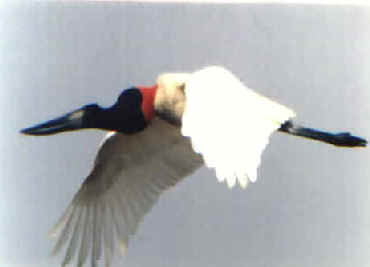
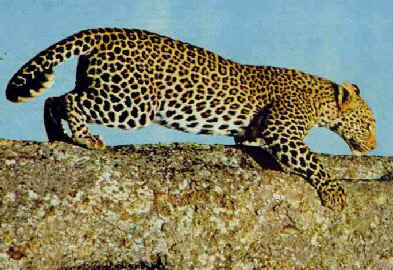
Not only would the "2
J's" be sought,
"the Jabiru & the Jaguar".
we'll be in Areas with Spectacular Nature
where Concentrations occur of
an Assortment of Birds & Other
Wildlife
During this tour about 300 species of birds should be seen.
Often
staying not at
hotels, but at lodges
where wildlife is just outside the door !
For birds such as wild Hyacinth Macaws
in their natural environment,
and flocks of Jabirus and numerous other birds
in the fabulous Pantanal,
(truly one of the most fantastic birding areas in the world),
this is the tour!
This
could also be called our "Tuiuiu Tour",
as that's the local word in the Pantanal for
the "Jabiru".
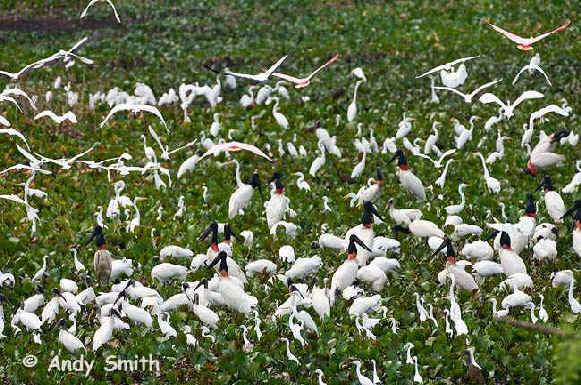
Birds
in the Pantanal of Mato Grosso do Sul,
mostly Egrets & Jabiru Storks,
photographed during a previous
FONT Brazil Tour
Links:
Birds
during Previous Tours in Brazil:
Part
1: Tinamous to Flycatchers
Part 2: Antshrikes to Grosbeaks
Rare
& Threatened Birds of Brazil
Brazilian Mammals & Other Wildlife
Past Tour Highlights with Lists of Birds & Other Wildlife
A Photo Gallery of Birds & Animals during our Mato Grosso do Sul Tour in 2006
Itinerary (prices follow):
Tue,
Mar 9: Arrival in Brazil at the Sao Paulo airport in the morning
(after an overnight flight departing USA the previous evening, Mon, Mar
8).
From Sao Paulo, we travel by van north & west to a special place, for a very
special objective - one of the rarest of the world's birds, the Brazilian
Merganser. The special place is the Serra da
Canastra National Park.
Hopefully, we'll see it (the merganser, that is - as we have
during 6 FONT tours in that area, from 1997 thru 2008). We'll certainly
try. The entire population of the Brazilian Merganser has recently been
estimated at just about 200 birds.
We'll definitely be able to explore and enjoy the pristine grassland habitat,
with an assortment of birds and mammals, and with clear streams (favored by
the merganser) atop a high plateau. Around the perimeter of
the vast plateau there are over two dozen waterfalls, favored by various species
of nesting and roosting swifts. The Brazilian Merganser occurs at
the top and the bottom of one of those waterfalls. This remote area of Brazil is
a tremendous place.
Overnight in the area of Serra da Canastra.
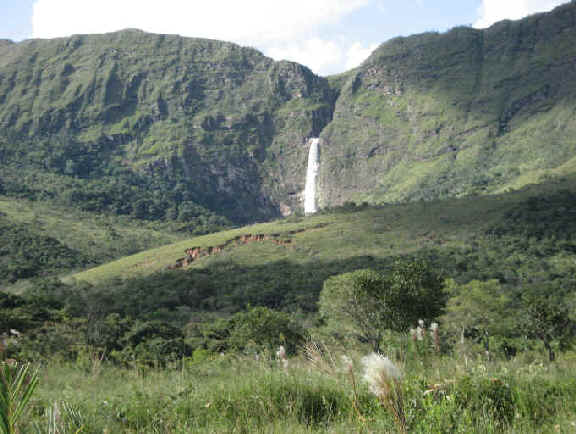
One
of the waterfalls at Canastra National Park,
photographed during a FONT tour in March.
Wed,
Mar 10: The first of two days in the area of Serra
da Canastra. During our previous tours, in this region, in addition
to the merganser, we've also seen other special birds such as the: Cock-tailed
Tyrant, Sharp-tailed Grass-Tyrant, Black-masked Finch, Ochre-bellied Pipit,
and Brasilia Tapaculo.
During our most-recent tour in the region, we had wonderful looks at a pair of Crowned
Solitary Eagles. Other notable birds such as Red-legged Seriemas, Toco
Toucans, White Woodpeckers, and Least Nighthawks were seen in
numbers. During another recent tour, the rare Sickle-winged Nightjar was
seen.
Canastra National Park is a striking place - as noted, a vast grassland, atop a
high plateau, where in addition to birds, mammals included the Giant
Anteater, Giant Armadillo, and Maned Wolf.
Overnight again in the area of Serra da Canastra.
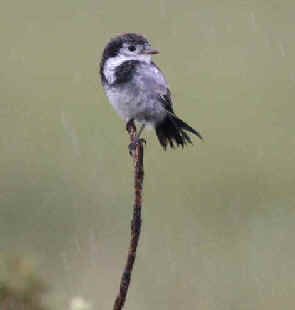
A
Cock-tailed Tyrant.
photographed during the FONT tour in March 2008.
Thu,
Mar 11: A second full-day in the area of Canastra
National Park. Our last overnight there.
Fri, Mar 12: Travel west, with birding
along the way, from the Brazilian state of Minas Gerais
into the state of Mato Grosso do Sul, yet
another area that's wonderful for wildlife.
Sat, Mar 13: Our first day in Mato
Grosso do Sul, during which a nice assortment of birds will be seen,
including our first macaws. During the tour, we'll see 3 large species
of macaws (the Blue-and-Yellow, the Red-and-Green,
and the rare Hyacinth) in addition to smaller macaws
and numerous parrots & parakeets. Between Canastra National
Park and Campo Grande, we'll be in the area of the beautiful Brazilian endemic,
the rare Golden-capped Parakeet.
Overnight in Campo
Grande.
Sun, Mar 14: This day, from the nice,
small city of Campo Grande, we'll be heading
into the renowned Pantanal. It's renowned
especially for wildlife, both birds and mammals. And, during our tour, we'll see
plenty of both.
The accommodations and the meals where we'll be staying in the Pantanal,
are good indeed, but the best aspect of the tour there would be the close accessibility
to the spectacular wildlife just referred to.
Our observation of the wildlife in the Pantanal would be from vehicles (wonderfully
designed for such observation) during day-trips and night-trips, and by
boat. Overnights would be 2 at the lodge (Mar 7-8).
Mon,
Mar 15 & Tue, Mar 16: During these days, we'll have a
diversified experience in the Pantanal, with
birds (many birds!) and other nature. There are lists
of the birds & other wildlife of the Pantanal (that we've seen there during our previous tours) elsewhere in this website, but, we'll note here, that just a
few of the birds would include:
Hyacinth Macaw (the largest macaw in the world),
Golden-collared
Macaw, Great Rufous Woodcreeper, Red-billed Scythebill, Helmeted Manakin,
and the Mato Grosso Antbird.
Among what's particularly spectacular are the large number of waterbirds. Ducks can be numerous in certain
rice-fields (where, during our previous tours, we've seen many whistling-ducks, comb-ducks,
and some others).
Other aquatic birds, numerous in the
Pantanal, would be: egrets,
herons, ibises, and storks (Wood & Maguari Storks
& Jabiru).
During one day of one of tours in the Pantanal, we saw an estimated thousand Jabiru, either on
the ground or soaring in the sky! Also adding to the mix would be Limpkins and Roseate Spoonbills.
And Sunbitterns
and Sungrebes also occur. Boat-billed Herons also do. And we'll
make an effort to see yet another heron that's along the rivers - the rare
skulker, the Agami Heron.
Landbirds, in the trees or in the air, would be parrots and
parakeets, and raptors of various kinds.
Possible at dusk, and after dark, would be 2 species of Potoos (the Great
& the Gray, formerly called the Common), nightjars
& nighthawks, and an owl or two. (During our recent
tours, we've
enjoyed tremendous looks, after dark, of Striped Owls and Barn Owls.)
Mammals after dark should be those that are common, such as fox
and bats, but it must be noted there's JAGUAR in the
area. With good luck .... During our tours here in September 2006, August 2007,
& March 2009, we saw this elusive
cat. We'll be making, if necessary, 2 night-time excursions for it, and other
creatures. Pumas can also be seen (with luck).
Also during our tours, we had, at night, nice looks at Ocelots (as many
as 7 during 1 outing), a Pantanal
(formerly Pampas) Cat, Brazilian Tapirs, and Maned
Wolf, in addition to a number of other
animals including: Marsh Deer, Crab-eating Foxes and Crab-eating
Raccoons, and Giant Anteaters. During a previous stay
at one of the lodges, we saw as many as 8 Giant
Anteaters.
Another anteater, the Tamandua is also possible. During the day, monkeys and marmosets can be seen in the
trees. Numerous caimans will be in & near the water.
During our overnights in the Pantanal (and after our evening excursions), we
should hear, from the lodges, an assortment of sounds including those of limpkins,
owls, and nightjars. At dawn, howler monkeys.
Our last night in the state of
Mato Grosso do Sul (Mon, Mar 9), would be back in the city of Campo Grande. Overnight, there,
would be convenient to the airport.
Wed, Mar 17:
After some morning
birding, we'll go to the airport at Campo Grande, for a flight to Sao Paulo to
connect with departure, for those leaving Brazil, in the evening on an overnight flight home
(arriving in North America the a.m. of Thursday, Mar 18.)
An Optional Extension in Southeastern Brazil
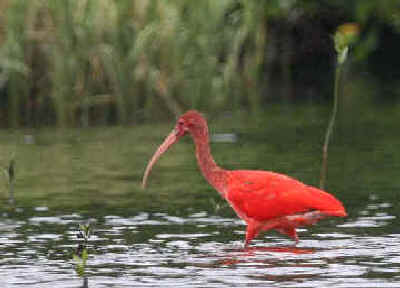
A
Scarlet Ibis, photographed during the FONT tour
in southeast Brazil in March.
Wed, Mar
17: For those continuing in Brazil, after arrival
at the Sao
Paulo airport from Campo Grande, overnight near the airport.
Thu, Mar 18: Early in the morning,
we'll head to the Brazilian seacoast of the South
Atlantic Ocean. In that area, we'll take two boat-trips.
One boat-trip will be in an area marsh and mangroves, where there will be an assortment of
birds from the litte Bicolored Conebill to some large birds including waders
and raptors. But the most notable of the birds will be the Scarlet
Ibis. There's a flock of the bright red birds occurs in the area that's the only
population of the species south of the Amazon, and is isolated by many miles
from others of its kind. This boat-trip will be done when the tide is best for
it.
The other boat-trip will be out from the estuary to the ocean ocean where our
quest will be petrels, shearwaters, terns and gulls, and maybe
with good fortune, even an albatross.
We'll overnight again back near the Sao Paulo airport.
Fri
Mar 19: Travel, this morning, east toward another part of the
Brazilian seacoast, specifically to Ubatuba,
with some birding along the way in areas of rice fields, for raptors and waterfowl
such as the Comb Duck, and Araucaria Forest. Araucaria ("monkey-puzzle"
) trees are native to southern Brazil, and they're favored by a number
of native birds.
Overnight
at Ubatuba.
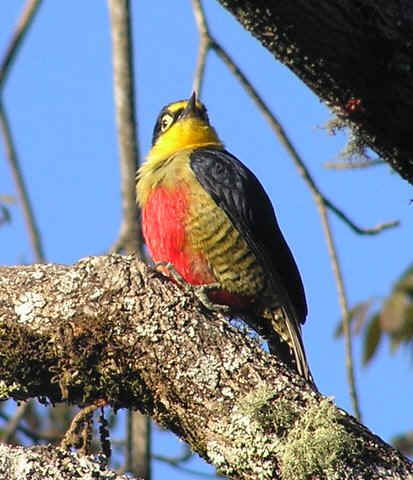
A
Yellow-fronted Woodpecker
photographed during a FONT tour in southeast Brazil,
a colorful bird with more than yellow in its plumage.
(photo by Rosemary Lloyd)
Sat, Mar 20: Birding in the area of Ubatuba,
where there will be many birds to see in the lower elevations of the Atlantic Forest. One
species, a small cotinga, called the Buff-throated Purpletuft, is
virtually endemic to this region. It's silent. The Bare-throated Bellbird, also
in the area, is not. In this coastal region, also with portions of the Atlantic
Forest, many of the birds will be different than those where we were earlier at
the higher elevations at Itatiaia. This is the case with tanagers, flycatchers,
hummingbirds, antbirds, and others.
Sun, Mar 21: After another fine
morning of Ubatuba birding, travel in the afternoon to the Sao
Paulo International Airport, for the departure for home (arriving in North
America the a.m. of Monday, Mar 22).
![]()
Prices:
For the tour in Brazil March 8-17:
US $2,895 per person, based upon double occupancy
Single supplement: US $325
For the tour in Brazil March 8-22, with the extension in southeast
Brazil:
US $3,495 per person, based upon double occupancy
Single supplement: US $395
Prices include:
All overnight accommodations.
Meals
Ground transportation within Brazil.
Services of the FONT birding tour leader.
Prices
do not include:
Drinks
and other items of a personal nature.
International flights to/from Brazil.
Domestic flights within Brazil.
A
deposit of US $500 required to register for the tour.
![]()
some birds & animals
in the Pantanal of Mato Grosso do Sul
as
photographed during FONT's September 2006 Tour
All of the following photographs were taken during the tour
by Andy Smith of Pennsylvania, USA - © -
all rights reserved.
www.andysmithphotography.com
Our Upcoming Birding & Nature Tours in Brazil
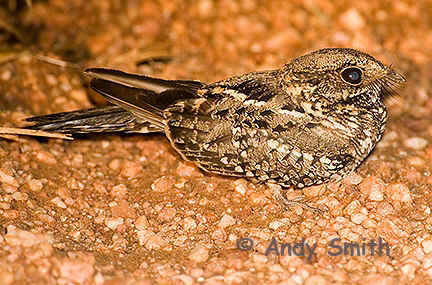
Little Nightjar
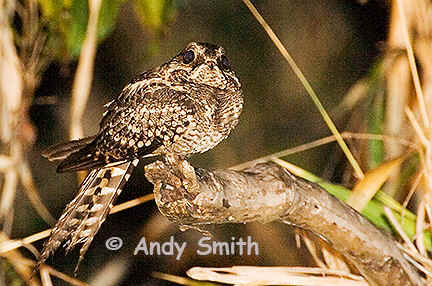
Scissor-tailed Nightjar
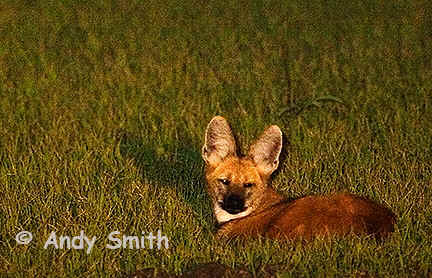
Maned Wolf
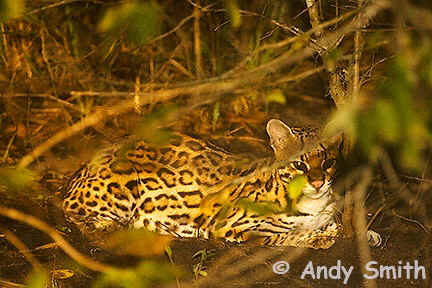
Ocelot
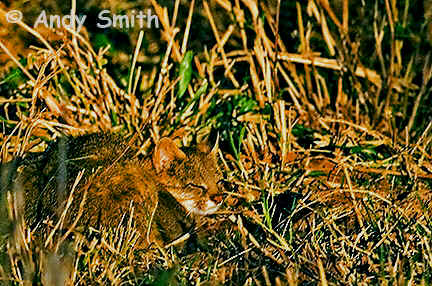
Pantanal Cat
(formerly Pampas Cat)
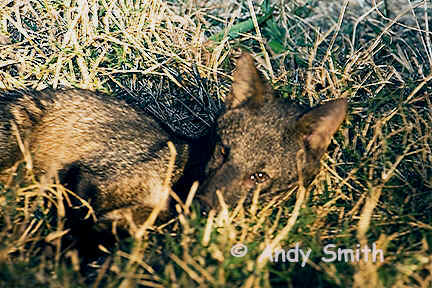
Crab-eating Fox
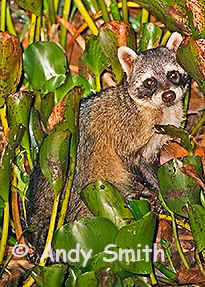
Crab-eating Raccoon